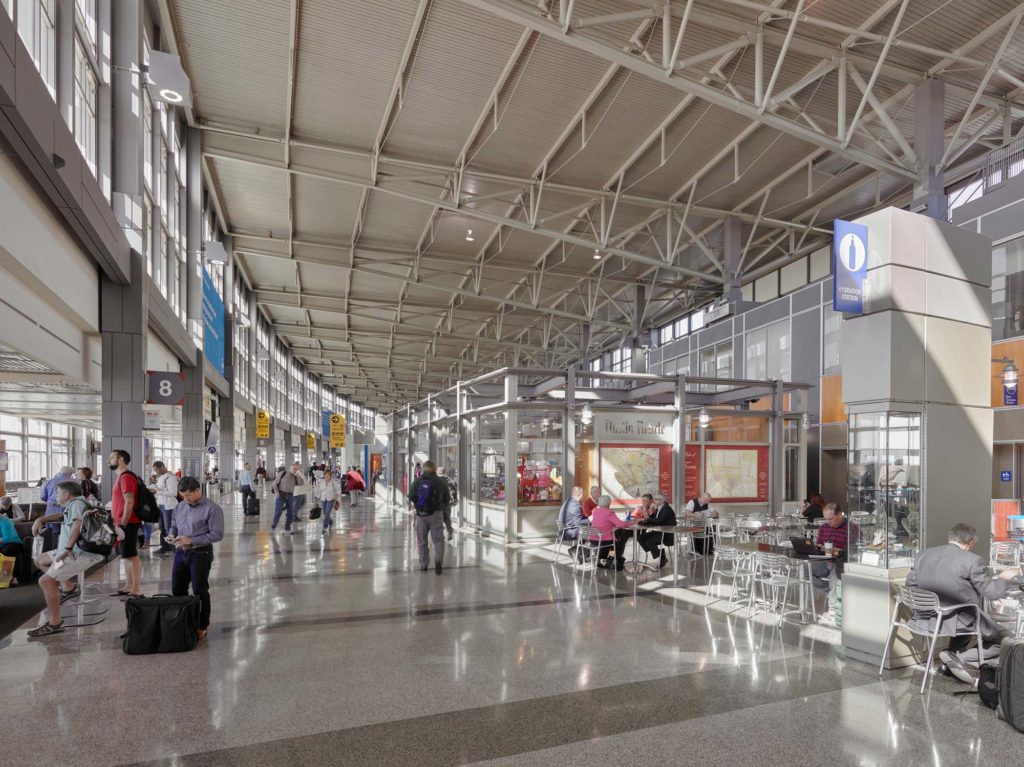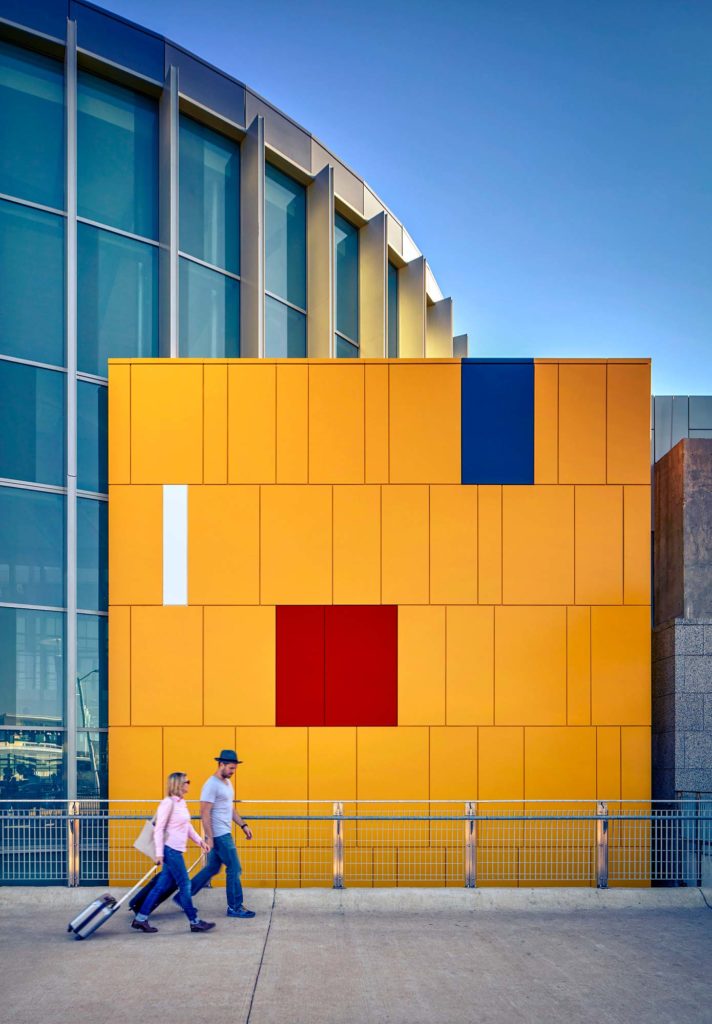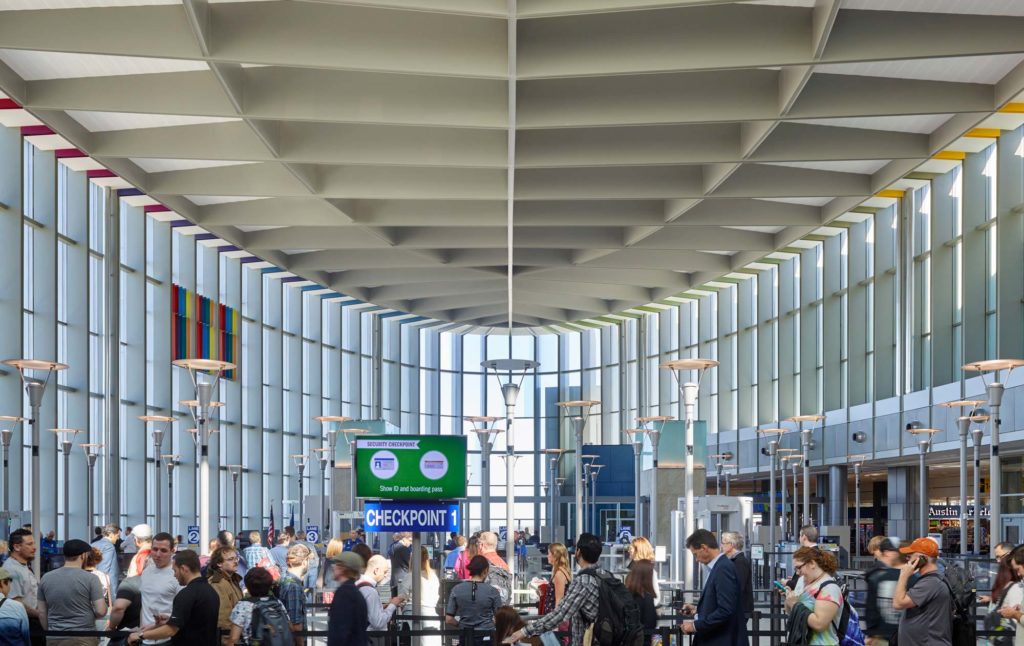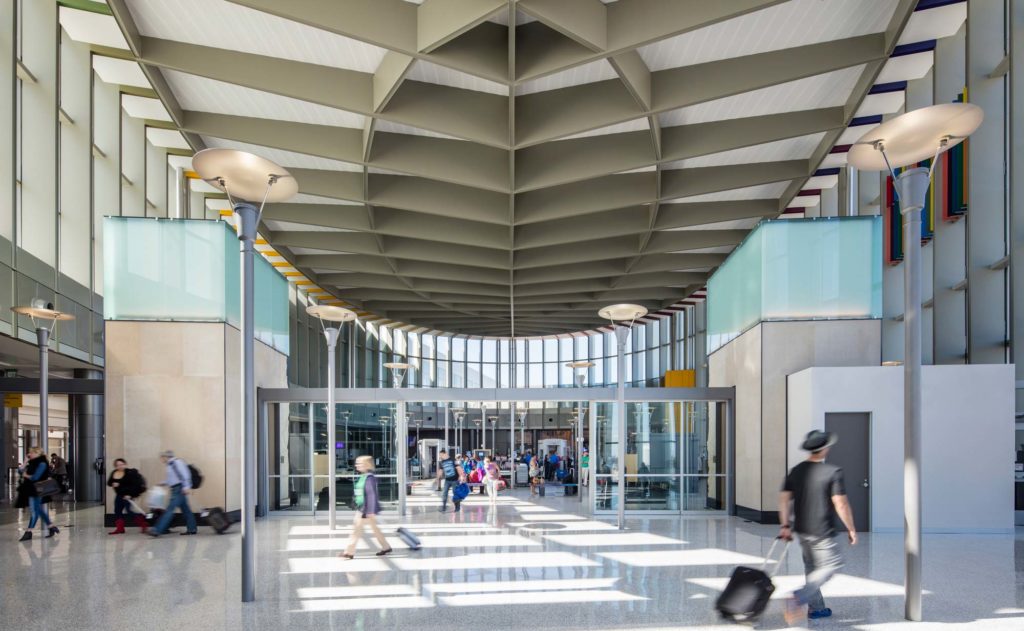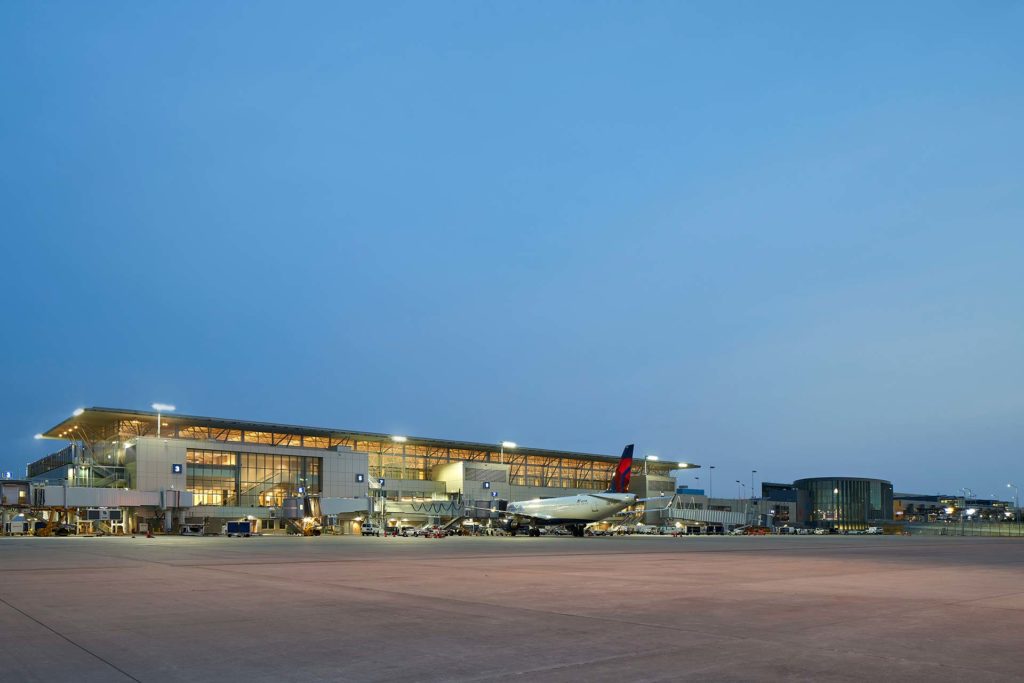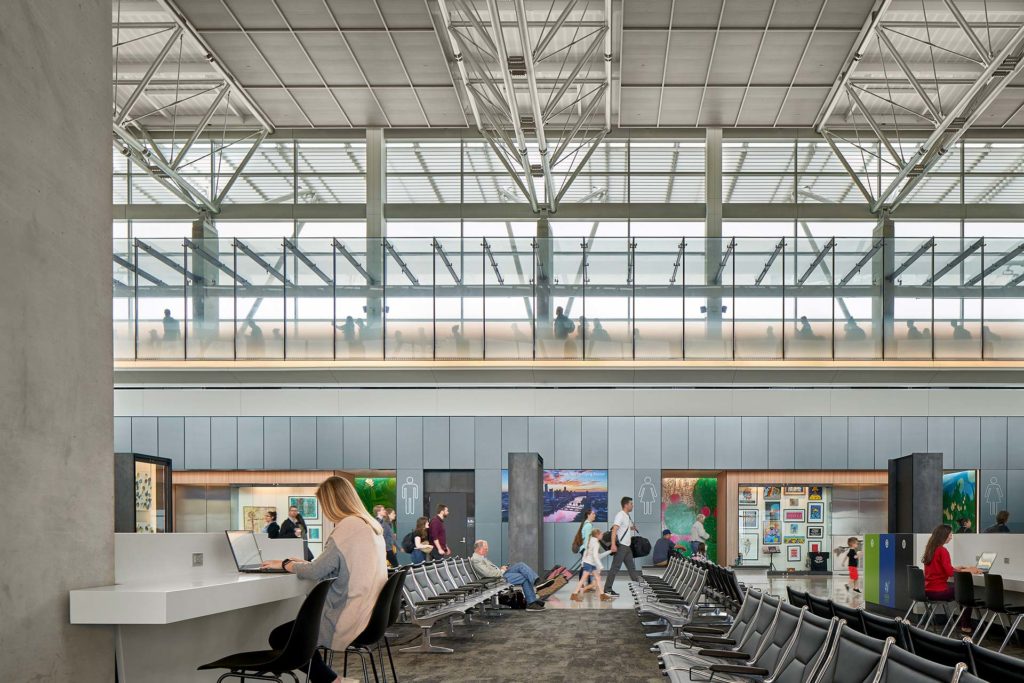- Built:
- 1942-1993 (as Bergstrom Air Force Base); 1999 (Civilian passenger operations begin)
- Alterations:
- See Placemaking below; numerous iterations
- Style:
- Contemporary
Description
The 4,242-acre airport has two runways (a 12,250-foot runway dedicated to former president Lyndon Baines Johnson and a 9,000-foot runway dedicated to former congressman J.J. “Jake” Pickle) and 34 total gates in the main 660,000-square-foot Barbara Jordan Terminal and three gates at the South Terminal. Open to the public in May 1999, it replaced Robert Mueller Municipal Airport. Peaking at over 16 million passengers in pre-pandemic 2019, AUS continues to house the Armed Forces Reserve Center, private and cargo aviation facilities, administrative, maintenance, and technology support buildings, as well as numerous parking structures, retail, and restaurant buildings.
Placemaking
In the 1890s, cowboys drove more than five million cattle and a million mustangs on the Chisholm Trail, through the airport land, up Congress Avenue past the Texas Capitol Building, and on to the stockyards in Kansas. Fifty years later, in 1942, the U.S. Army established the Del Valle Army Air Base. The name of the base was changed to Bergstrom Army Airfield in March 1943 in honor of Capt. John August Earl Bergstrom, the first Austinite killed in WWII at Clark Field, Philippines. During WWII, the airbase was a training facility for crews of invasion gliders and twin-engine Douglas C-47 tow planes that participated in the D-Day invasion of Normandy. After the war, the base supported the Berlin Airlift.
Renamed Bergstrom Air Force Base in December 1948, the base has hosted significant aviation events, including a 1955 Atlantic crossing of Austin-based fighter jets crews that pioneered aerial refueling techniques, flying directly from Sturgate, England in a record-setting 10 hours and 48 minutes. During the 1960s, Air Force One was a frequent guest, flying President Lyndon Johnson between Washington and his Johnson City ranch. In 1979, the Concorde visited Bergstrom, and in 1981 and 1985 the Space Shuttles Columbia and Discovery circled the city aboard their carrier aircraft before staying overnight. on In 1993, Bergstrom officially closed as an Air Force base and reopened to passenger service as Austin Bergstrom International Airport on May 23, 1999.
Before being renovated, the Hilton Austin Airport Hotel was the headquarters for Bergstrom Air Force Base. The two-story, circular building has a large outdoor central plaza and was nicknamed the Doughnut. It had 123,210 square feet of floor space and an overall building diameter of 312 feet—slightly longer than a football field. It had 500 windows, almost 20,000 cubic yards of concrete weighing nearly 1,500 tons, 760 tons of reinforced steel, and a 500-ton air conditioning system powerful enough to cool 170 averaged-sized homes. It was also referred to as The Little Pentagon and the Roundagon.
The reinforced concrete basement under the plaza was designed to be a secure area. Guard cages at three entrances to the plaza were made of concrete with bullet-resistant windows. Bergstrom Air Force Base was one of three Cold War bunkers in the U.S. where the President of the United States could be flown for safety in the event of a nuclear attack. Despite discouragement by base engineers, the Doughnut was also home to several colonies of Mexican Freetail Bats before they became famous residents and icons of the renovated Congress Avenue Bridge.
The terminal is named after Barbara Jordan, the first African American person elected to the Texas Senate in 1966. She was elected as president of the Texas Senate in 1972. Later that year she was elected to the U.S. House of Representatives, along with Andrew Young of Georgia, the first African American politicians in the twentieth century elected to Congress from the Deep South. Jordan rose to national prominence while serving on the House Judicial Committee when articles of impeachment were served against President Richard M. Nixon. Her opening remarks shook the committee room, and the large television audience, making her a national political figure. Jordan lived in Austin after she retired from Congress.
The original Barbara Jordan Terminal building, with design lead Larry Speck, FAIA, is a daylit, open steel crescent that minimizes distance between the entrance and boarding gates and offers sweeping views of the apron, airstrip, and sky. Its features are rooted in the local cultural landscape with materials like Texas Pearl pink granite, ubiquitous public art, numerous local restaurants, and a central music stage. In 2019, AUS began a partnership with local public radio station KUTX 98.9 FM to curate a live-streamed playlist of Austin artists. Most restaurants and merchants are Austin originals and welcome visitors to the Austin lifestyle and vibe.
Connections to the local community are also featured in the the 2019 Terminal Expansion project. Inspired by the traditional Texas dance hall at Gruene, the high central ceiling and lower gates continue the emphasis on tying spaces to their Austin roots. Daylighting, exposed steel trusses, and details of the original terminal continue throughout the 12 new gates, which include an overhead international flight corridor, an observation deck, and pet spaces. There is even a nod to Austin’s Moonlight Towers in the elevated Delta Sky Club. These interpretations of local landmarks and spaces reference spatial and cultural values of Austin, resulting in a combination of reified informality and clean, international modernity befitting the increasingly cosmopolitan evolution of a once-sleepy college town. – Riley Triggs, AIA
Sustainability Highlights
- The first act of reuse and sustainability in the construction of the airport was the reuse of the existing infrastructure of a U.S. Air Force base, including a 12,250-foot runway.
- All concrete from demolition was recycled as sub-base material on other airport paving projects.
- All demolished asphalt was recycled as fill and all excavation materials were reused for other projects on the site.
- AUS uses renewable natural gas to power the shuttle bus fleet and in 2021 brought Sustainable Aviation Fuel (SAF) to the airport. SAF is a clean substitute for fossil jet fuels produced from sustainable resources such as biological waste oils, agricultural residues or non-fossil CO2.
- The airport’s first LEED Silver building was a rental car facility constructed in 2011.
- The 2019 nine-gate terminal expansion achieved LEED Gold for New Construction with a 99.5% construction waste diversion rate. This included 22% of total building materials manufactured within 500 miles of the project site. Natural lighting and advanced controls resulted in a 22% energy cost savings rate, and efficient fixtures reduced water use by 37%. Almost 30% of the construction materials contained recycled content and the terminal diverts 38% of its waste from landfills annually.
- Austin Energy’s GreenChoice® renewable energy provides 100% of the terminal’s electricity, eliminating the same amount of carbon from the air as six million trees annually.
- The airport purchases renewable energy and carbon offsets from sustainable sources and promotes The Good Traveler program to AUS passengers to make their air travel more sustainable.
Points of Interest
Hilton Austin Airport Hotel / 12th Air Force Headquarters
Built: 1968; renovated 2001
Architect: Page Southerland Page,
Builder: Stokes Construction
AUS Barbara Jordan Terminal
Built: 1998
Architects: Gensler Architects; Page Southerland Page
Builder: Morganti Group
AUS Ground Transportation Staging Area (GTSA)
LEED Gold (U.S. Green Building Council)
Built: 2000; addition 2012
Architect: Sunland Group
Landscape Architect: Winterowd Associates
Builder: The Barr Company
AUS East Terminal Infill
LEED Silver
Built: 2015
Architect: Page Southerland Page
Builder: Hensel Phelps
AUS Administration
LEED Silver
Built: 2020
Architect: PGAL
Builder: Austin Commercial
AUS Terminal Expansion
LEED Gold
Built: 2019
Architects: Gensler; Sunland Group
Builder: Hensel Phelps
ABIA Consolidated Maintenance Facility
LEED Silver (anticipated)
Built: 2021
Architect: Atkins Global
Builder: JE Dunn
AUS Information Technology
LEED Silver (anticipated)
Built: 1952; renovation 2021
Architect: Page Southerland Page
Builder: Austin Commercial
Tim Griffith (1-5); Dror Baldinger, FAIA (6-7); Ryan Conway (8)
